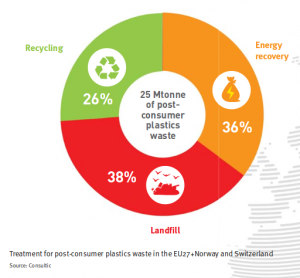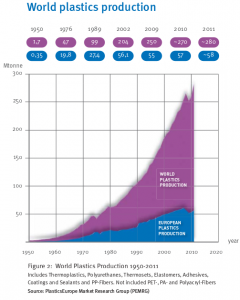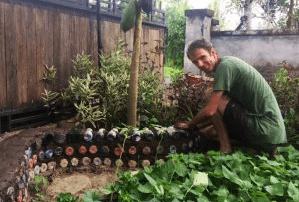Yes, “Evil” is a strong word– especially for a seemingly banal and even benevolent activity that we all aspire to participate in. However, after several years of working closely with waste, up-cycling and recycling, I have serious doubts about Recycling’s benevolence. It appears to me that there is a dark reality lurking behind it. Thankfully, I am also starting to see the solution– but you’re not going to like it.
What do I mean by an ‘Evil Illusion’?

Sauroman the White Wizard: A Good Guy?
But all is not as it seems. Our belief that recycling is Good is much the same.
In The Lord of the Rings, the heroes of the story, believing in Sauroman’s goodness, are distracted. Sauroman is able to plunder the forests, raise an army of darkness and destroy and maraud the land. In the end, the entire world is threatened.
Sound a little familiar? Recycling likewise lulls us into the illusion that all is well, while behind its Green façade the cogs of darkness and destruction turn with inexorable certainty.
In nature, when a leaf falls from a tree, 100% of its nutrients biodegrade and are recycled (in the true meaning of the word) back into the local ecosystem. This all happens within a few dozen square meters. When a plastic bottle is tossed into a blue bin it begins a process of a fundamentally different sort: a high-energy journey around the planet, bouncing from one factory and superstore to another where it inevitably crash-lands into a distant ecosystem.
I recently took a job at state-of-the art recycling plant to experience first hand how recycling works in Canada. There, massive amounts of plastic passed me by. Like PET bottles. Let me use this as an example. A high percentage of PET (plastic #1) is in fact “recycled”. However, unlike a fallen leaf, it isn’t recycled in the same region or even continent. In most cases in North America, bales of PET are shipped off to Asia to be processed. A massive and largely petrol-fueled system of container ships, factories, foundries, machines of all shapes and sizes, are employed to make this happen.

According to PlasticsEurope, 38% of plastic waste goes to the landfills. The 26% that is recycled will eventually be unrecyclable. Energy recovery has been criticized for its release green house gases.
In Europe in 2012, 38% of plastic waste was not recycled. But this number in itself is misleading– because eventually all PET will be lost, be worn, or be too dirty to be recycled. Eventually all PET is recycled down a number. And then eventually that plastic is recycled down another number. Finally, the material is recycled down into something that just can’t be recycled any more. With great dismay I watched our recycling factory direct tons of unrecyclable styrofoams, soft plastics, bubble wrap, plastic lined coffee cups, etc. to the trash bin.
Of course, all these plastics that are trashed have to go somewhere. In the case of the plant where I worked, they are shipped off to an “engineered sanitary landfill”. But let’s not forget what every landfill used to be– a field, a forest, an ecosystem of which we were connected, and still are connected.
In the Lord of the Rings a similar thing happens, Sauroman chops down his oak groves. While the heroes of the story are distracted elsewhere, he raises an army of darkness to threaten the world. 
The Illusion of Recycling enables a similar army darkness. Lulled into the belief that each piece of plastic is recycled, we continue buying and consuming pieces of plastic without any qualm or hesitation. We ignore the fact that for each plastic bag/toy/cup, consumed another is made to take its place.
 One could argue that recycling reduces the need to make as many replacements from new plastic. However, this ignores the sociology of consumption. Precisely because there appears to be a solution, demand remains unabated. Indeed, global demand for plastics has been relentlessly increasing over the last decades. Masses of new plastics are churned out daily, just as on the other side, masses flow into the ocean. Recycling doesn’t reduce plastic creation and dumping, it increases it.
One could argue that recycling reduces the need to make as many replacements from new plastic. However, this ignores the sociology of consumption. Precisely because there appears to be a solution, demand remains unabated. Indeed, global demand for plastics has been relentlessly increasing over the last decades. Masses of new plastics are churned out daily, just as on the other side, masses flow into the ocean. Recycling doesn’t reduce plastic creation and dumping, it increases it.
That would explain why dumps in North America are overflowing. It would also explain why oceans are filling with materials that simply do not fit back into the ecological cycles.
Dump sites tend to be far away and few of us walk the ocean shorelines. The Great Illusion thus remains strong. The heros go about their daily business without giving pause to the dark armies massing around Sauroman’s tower. Indeed, to an alien looking down at the colossal grey factories, the great machines of oil extraction, refinement and fabrication they would surely seem like a great grey army marching against the green biosphere.
So what then to do with that plastic bag? That pop bottle? That styrofoam packaging?
Well, as I mentioned before, I’ve got the solution for you.
We’ve handed the responsibility to others for long enough. By-pass the illusion once and for all and take responsibility for your consumption: Store your plastics and assorted waste in a box until it is good and full. Put it into your car and drive out of town. Find a farmer’s field, a forest or an isolated riverside– you’ll want to be sure no one sees you. If you live near the ocean, even better– find a remote cliff or beach. Park.
Lift the box out of the trunk and dump it all out.
And feel the knowing.
That is the eventual fate of every molecule of the packaging and products that we consume. Whether it passes through a dozen recycling plants, a hundred shops and stores, that is where it is heading: Into the circles of life there to sustain us, our children, our children’s children and the children of all species.
______
References:


